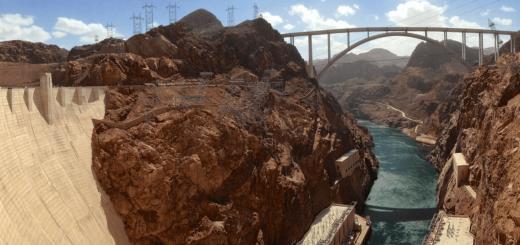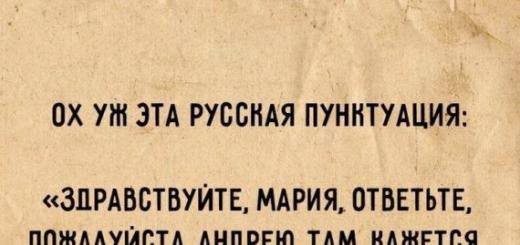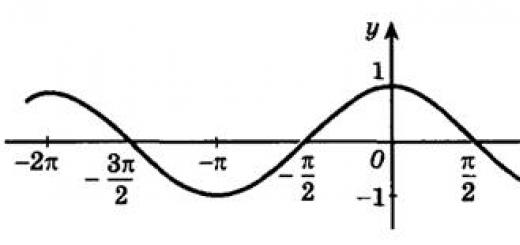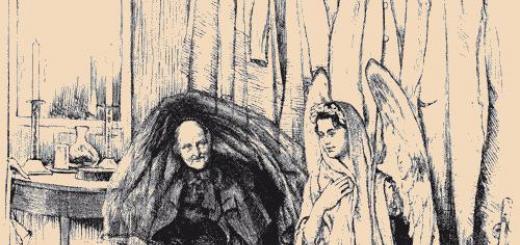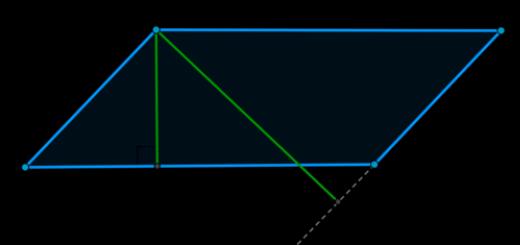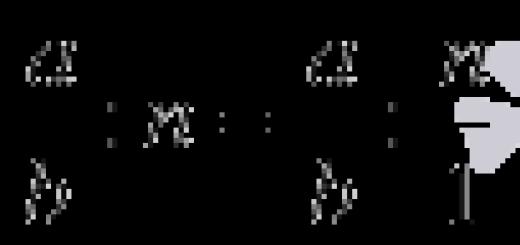Definition. A parallelogram is a quadrilateral whose opposite sides are pairwise parallel.
Property. In a parallelogram, opposite sides are equal and opposite angles are equal.
Property. The diagonals of a parallelogram are bisected by the intersection point.

1 sign of a parallelogram. If two sides of a quadrilateral are equal and parallel, then the quadrilateral is a parallelogram.
2 sign of a parallelogram. If the opposite sides of a quadrilateral are equal in pairs, then the quadrilateral is a parallelogram.
3 sign of a parallelogram. If in a quadrilateral the diagonals intersect and the intersection point is bisected, then this quadrilateral is a parallelogram.
Definition. A trapezoid is a quadrilateral in which two sides are parallel and the other two sides are not parallel. Parallel sides are called grounds.

The trapezoid is called isosceles (isosceles) if its sides are equal. In an isosceles trapezoid, the angles at the bases are equal.

A trapezoid with one right angle is called rectangular.

The segment connecting the midpoints of the sides is called midline of the trapezoid. The middle line is parallel to the bases and equal to their half-sum.

Definition. A rectangle is a parallelogram with all right angles.

Property. The diagonals of a rectangle are equal.
Rectangle sign. If the diagonals in a parallelogram are equal, then this parallelogram is a rectangle.
Definition. A rhombus is a parallelogram in which all sides are equal.
Property. The diagonals of a rhombus are mutually perpendicular and bisect its angles.

Definition. A square is a rectangle in which all sides are equal.
A square is a particular kind of rectangle, and also a particular kind of rhombus. Therefore, it has all their properties.
Properties:
1. All corners of the square are right
2. The diagonals of the square are equal, mutually perpendicular, the intersection point is divided in half and the corners of the square are divided in half.

With four corners and four sides. A quadrilateral is formed by a closed polyline, consisting of four links, and that part of the plane that is inside the polyline.
The designation of a quadrilateral is made up of the letters at its vertices, naming them in order. For example, they say or write: quadrilateral ABCD :
In a quadrilateral ABCD points A, B, C and D- this is quadrilateral vertices, segments AB, BC, CD and DA - sides.
Vertices that belong to the same side are called neighboring, vertices that are not adjacent are called opposite:

In a quadrilateral ABCD peaks A and B, B and C, C and D, D and A are adjacent, and the vertices A and C, B and D- opposite. Angles lying at adjacent vertices are also called neighboring, and at opposite vertices - opposite.
The sides of a quadrilateral can also be divided in pairs into adjacent and opposite sides: sides that have a common vertex are called neighboring(or related), sides that do not have common vertices - opposite:

Parties AB and BC, BC and CD, CD and DA, DA and AB are adjacent, and the sides AB and DC, AD and BC- opposite.
If opposite vertices are connected by a segment, then such a segment will be called the diagonal of the quadrilateral. Considering that there are only two pairs of opposite vertices in the quadrilateral, then there can be only two diagonals:

Segments AC and BD- diagonals.
Consider the main types of convex quadrilaterals:

- Trapeze- a quadrilateral in which one pair of opposite sides are parallel to each other, and the other pair is not parallel.
- Isosceles trapezium- a trapezoid whose sides are equal.
- Rectangular trapezoid A trapezoid with one of the right angles.
- Parallelogram A quadrilateral in which both pairs of opposite sides are parallel to each other.
- Rectangle A parallelogram in which all angles are equal.
- Rhombus A parallelogram with all sides equal.
- Square A parallelogram with equal sides and angles. Both a rectangle and a rhombus can be a square.
Corner properties of convex quadrilaterals
All convex quadrilaterals have the following two properties:
- Any internal angle less than 180°.
- The sum of the interior angles is 360°.
In the school curriculum, geometry lessons have to deal with various types of quadrilaterals: rhombuses, parallelograms, rectangles, trapezoids, squares. The very first shapes to study are a rectangle and a square.
So what is a rectangle? The definition for the 2nd grade of a comprehensive school will look like this: this is a quadrilateral, in which all four corners are right. It is easy to imagine what a rectangle looks like: it is a figure with 4 right angles and sides parallel to each other in pairs.
In contact with
How to understand, solving the next geometric problem, what kind of quadrilateral are we dealing with? There are three main features, by which you can accurately determine that we are talking about a rectangle. Let's call them:
- the figure is a quadrilateral with three angles equal to 90°;
- the presented quadrilateral is a parallelogram with equal diagonals;
- a parallelogram that has at least one right angle.
It is interesting to know: what is convex, its features and signs.
Since a rectangle is a parallelogram (i.e., a quadrilateral with pairwise parallel opposite sides), then all its properties and features will be fulfilled for it.
Formulas for calculating the length of the sides
in a rectangle opposite sides are equal and mutually parallel. The longer side is usually called the length (denoted by a), the shorter side is called the width (denoted by b). In the rectangle in the image, the lengths are sides AB and CD, and the widths are AC and B.D. They are also perpendicular to the bases (i.e., they are heights).
To find the sides, you can use the formulas below. Conventions are adopted in them: a - the length of the rectangle, b - its width, d - the diagonal (the segment connecting the vertices of two angles lying opposite each other), S - the area of the figure, P - the perimeter, α - the angle between the diagonal and the length, β is an acute angle formed by both diagonals. Ways to find the lengths of the sides:
- Using the diagonal and the known side: a \u003d √ (d ² - b ²), b \u003d √ (d ² - a ²).
- By the area of the figure and one of its sides: a = S / b, b = S / a.
- Using the perimeter and the known side: a = (P - 2 b) / 2, b = (P - 2 a) / 2.
- Through the diagonal and the angle between it and the length: a = d sinα, b = d cosα.
- Through the diagonal and the angle β: a = d sin 0.5 β, b = d cos 0.5 β.
Perimeter and area
 The perimeter of a quadrilateral is called the sum of the lengths of all its sides. To calculate the perimeter, the following formulas can be used:
The perimeter of a quadrilateral is called the sum of the lengths of all its sides. To calculate the perimeter, the following formulas can be used:
- Through both sides: P = 2 (a + b).
- Through the area and one of the sides: P \u003d (2S + 2a ²) / a, P \u003d (2S + 2b ²) / b.
An area is a space bounded by a perimeter. Three main ways to calculate the area:
- Through the lengths of both sides: S = a*b.
- Using the perimeter and any one known side: S \u003d (Pa - 2 a ²) / 2; S = (Pb - 2b²) / 2.
- Diagonally and angle β: S = 0.5 d² sinβ.
In the tasks of a school mathematics course, it is often required to have a good command of properties of the diagonals of a rectangle. We list the main ones:
- The diagonals are equal to each other and are divided into two equal segments at the point of their intersection.
- The diagonal is defined as the root of the sum of both sides squared (follows from the Pythagorean theorem).
- The diagonal divides the rectangle into two triangles with a right angle.
- The point of intersection coincides with the center of the circumscribed circle, and the diagonals themselves coincide with its diameter.
The following formulas are used to calculate the length of the diagonal:
- Using the length and width of the figure: d = √ (a ² + b ²).
- Using the radius of a circle circumscribed around a quadrilateral: d = 2 R.
Definition and properties of a square
A square is a special case of a rhombus, parallelogram, or rectangle. Its difference from these figures is that all its angles are right, and all four sides are equal. A square is a regular quadrilateral.
A quadrilateral is called a square in the following cases:
- If it is a rectangle whose length a and width b are equal.
- If it is a rhombus with equal length diagonals and four right angles.
The properties of a square include all the previously discussed properties related to a rectangle, as well as the following:
- Diagonals are perpendicular to each other (property of a rhombus).
- The point of intersection coincides with the center of the inscribed circle.
- Both diagonals divide the quadrilateral into four identical right-angled and isosceles triangles.
Here are some frequently used formulas for  calculating the perimeter, area and elements of a square:
calculating the perimeter, area and elements of a square:
- Diagonal d = a √2.
- Perimeter P = 4 a.
- Area S = a².
- The radius of the circumscribed circle is half the diagonal: R = 0.5 a √2.
- The radius of an inscribed circle is defined as half the side length: r = a / 2.
Sample questions and tasks
Let's analyze some of the questions that you may encounter when studying mathematics at school, and solve a few simple problems.
Task 1. How will the area of a rectangle change if the length of its sides is tripled?
Solution : Let's denote the area of the original figure as S0, and the area of the quadrilateral with triple the length of the sides - S1. According to the formula considered earlier, we obtain: S0 = ab. Now let's increase the length and width by 3 times and write: S1= 3 a 3 b = 9 ab. Comparing S0 and S1, it becomes obvious that the second area is 9 times larger than the first.
Question 1. Is a quadrilateral with right angles a square?
Solution : It follows from the definition that a figure with right angles is a square only if the lengths of all its sides are equal. Otherwise, the figure is a rectangle.
Task 2. The diagonals of a rectangle form an angle of 60 degrees. The width of the rectangle is 8. Calculate what the diagonal is.
Solution: Recall that the diagonals are bisected by the intersection point. Thus, we are dealing with an isosceles triangle with an angle at the vertex equal to 60°. Since the triangle is isosceles, the angles at the base will also be the same. By simple calculations, we get that each of them is equal to 60 °. It follows that the triangle is equilateral. The width we know is the base of the triangle, so half of the diagonal is also 8, and the length of the whole diagonal is twice that and equal to 16.
Question 2. Does a rectangle have all sides equal or not?
Solution : Suffice it to recall that all sides must be equal for a square, which is a special case of a rectangle. In all other cases, a sufficient condition is the presence of at least 3 right angles. The equality of the parties is not a mandatory feature.
Task 3. The area of the square is known and equal to 289. Find the radii of the inscribed and circumscribed circles.
 Solution :
According to the formulas for the square, we will carry out the following calculations:
Solution :
According to the formulas for the square, we will carry out the following calculations:
- Let's determine what the main elements of the square are equal to: a = √ S = √289 = 17; d = a √2 =1 7√2.
- Let's calculate what the radius of the circle described around the quadrilateral is equal to: R = 0.5 d = 8.5√2.
- Let's find the radius of the inscribed circle: r = a / 2 = 17 / 2 = 8.5.
A convex quadrilateral is a figure consisting of four sides connected to each other at the vertices, forming four angles together with the sides, while the quadrangle itself is always in the same plane relative to the straight line on which one of its sides lies. In other words, the entire figure is on one side of any of its sides.
In contact with
As you can see, the definition is quite easy to remember.
Basic properties and types
Almost all figures known to us, consisting of four corners and sides, can be attributed to convex quadrilaterals. The following can be distinguished:
- parallelogram;
- square;
- rectangle;
- trapezoid;
- rhombus.
All these figures are united not only by the fact that they are quadrangular, but also by the fact that they are also convex. Just look at the diagram:
The figure shows a convex trapezoid. Here you can see that the trapezoid is on the same plane or on one side of the segment. If you carry out similar actions, you can find out that in the case of all other sides, the trapezoid is convex.
Is a parallelogram a convex quadrilateral?
 Above is an image of a parallelogram. As can be seen from the figure, parallelogram is also convex. If you look at the figure with respect to the lines on which the segments AB, BC, CD and AD lie, it becomes clear that it is always on the same plane from these lines. The main features of a parallelogram are that its sides are pairwise parallel and equal in the same way as opposite angles are equal to each other.
Above is an image of a parallelogram. As can be seen from the figure, parallelogram is also convex. If you look at the figure with respect to the lines on which the segments AB, BC, CD and AD lie, it becomes clear that it is always on the same plane from these lines. The main features of a parallelogram are that its sides are pairwise parallel and equal in the same way as opposite angles are equal to each other.
Now, imagine a square or a rectangle. According to their main properties, they are also parallelograms, that is, all their sides are arranged in pairs in parallel. Only in the case of a rectangle, the length of the sides can be different, and the angles are right (equal to 90 degrees), a square is a rectangle in which all sides are equal and the angles are also right, while the lengths of the sides and angles of a parallelogram can be different.
As a result, the sum of all four corners of the quadrilateral must be equal to 360 degrees. The easiest way to determine this is by a rectangle: all four corners of the rectangle are right, that is, equal to 90 degrees. The sum of these 90-degree angles gives 360 degrees, in other words, if you add 90 degrees 4 times, you get the desired result.
Property of the diagonals of a convex quadrilateral
The diagonals of a convex quadrilateral intersect. Indeed, this phenomenon can be observed visually, just look at the figure:
The figure on the left shows a non-convex quadrilateral or quadrilateral. As you wish. As you can see, the diagonals do not intersect, at least not all of them. On the right is a convex quadrilateral. Here the property of diagonals to intersect is already observed. The same property can be considered a sign of the convexity of the quadrilateral.
Other properties and signs of convexity of a quadrilateral
 Specifically, according to this term, it is very difficult to name any specific properties and features. It is easier to isolate according to different kinds of quadrilaterals of this type. You can start with a parallelogram. We already know that this is a quadrangular figure, the sides of which are pairwise parallel and equal. At the same time, this also includes the property of the diagonals of a parallelogram to intersect with each other, as well as the sign of the convexity of the figure itself: the parallelogram is always in the same plane and on one side relative to any of its sides.
Specifically, according to this term, it is very difficult to name any specific properties and features. It is easier to isolate according to different kinds of quadrilaterals of this type. You can start with a parallelogram. We already know that this is a quadrangular figure, the sides of which are pairwise parallel and equal. At the same time, this also includes the property of the diagonals of a parallelogram to intersect with each other, as well as the sign of the convexity of the figure itself: the parallelogram is always in the same plane and on one side relative to any of its sides.
So, the main features and properties are known:
- the sum of the angles of a quadrilateral is 360 degrees;
- the diagonals of the figures intersect at one point.
 Rectangle. This figure has all the same properties and features as a parallelogram, but all its angles are equal to 90 degrees. Hence the name, rectangle.
Rectangle. This figure has all the same properties and features as a parallelogram, but all its angles are equal to 90 degrees. Hence the name, rectangle.
Square, the same parallelogram, but its corners are right, like a rectangle. Because of this, a square is rarely called a rectangle. But the main distinguishing feature of a square, in addition to those already listed above, is that all four of its sides are equal.
The trapezoid is a very interesting figure.. This is also a quadrilateral and also convex. In this article, the trapezoid has already been considered using the example of a drawing. It is clear that she is also convex. The main difference, and, accordingly, a sign of a trapezoid is that its sides can be absolutely not equal to each other in length, as well as its angles in value. In this case, the figure always remains on the same plane with respect to any of the straight lines that connect any two of its vertices along the segments forming the figure.
Rhombus is an equally interesting figure. Partly a rhombus can be considered a square. A sign of a rhombus is the fact that its diagonals not only intersect, but also divide the corners of the rhombus in half, and the diagonals themselves intersect at right angles, that is, they are perpendicular. If the lengths of the sides of the rhombus are equal, then the diagonals are also divided in half at the intersection.
Deltoids or convex rhomboids (rhombuses) may have different side lengths. But at the same time, both the main properties and features of the rhombus itself and the features and properties of convexity are still preserved. That is, we can observe that the diagonals bisect the corners and intersect at right angles.
Today's task was to consider and understand what convex quadrilaterals are, what they are and their main features and properties. Attention! It is worth recalling once again that the sum of the angles of a convex quadrilateral is 360 degrees. The perimeter of figures, for example, is equal to the sum of the lengths of all segments forming the figure. The formulas for calculating the perimeter and area of quadrilaterals will be discussed in the following articles.
Types of convex quadrilaterals




Lesson topic
- Definition of a quadrilateral.
Lesson Objectives
- Educational - repetition, generalization and testing of knowledge on the topic: “Quadrangles”; development of basic skills.
- Developing - to develop students' attention, perseverance, perseverance, logical thinking, mathematical speech.
- Educational - through a lesson, to cultivate an attentive attitude towards each other, to instill the ability to listen to comrades, mutual assistance, independence.
Lesson objectives
- To form skills in building a quadrilateral using a scale bar and a drawing triangle.
- Check students' ability to solve problems.
Lesson Plan
- History reference. Non-Euclidean geometry.
- Quadrilateral.
- Types of quadrilaterals.
Non-Euclidean geometry
Non-Euclidean geometry, geometry similar to geometry Euclid in that it defines the movement of figures, but differs from Euclidean geometry in that one of its five postulates (second or fifth) is replaced by its negation. The denial of one of the Euclidean postulates (1825) was a significant event in the history of thought, for it served as the first step towards theory of relativity.
Euclid's second postulate states that any line segment can be extended indefinitely. Euclid apparently believed that this postulate also contained the statement that the straight line has infinite length. However in "elliptic" geometry any straight line is finite and, like a circle, is closed.
The fifth postulate states that if a line intersects two given lines so that the two interior angles on one side of it are less than two right angles in sum, then these two lines, if extended indefinitely, will intersect on the side where the sum of these angles is less than the sum two straight lines. But in "hyperbolic" geometry, there may exist a line CB (see Fig.), Perpendicular at point C to a given line r and intersecting another line s at an acute angle at point B, but, nevertheless, the infinite lines r and s will never intersect .
From these revised postulates it followed that the sum of the angles of a triangle, equal to 180° in Euclidean geometry, is greater than 180° in elliptic geometry and less than 180° in hyperbolic geometry.
